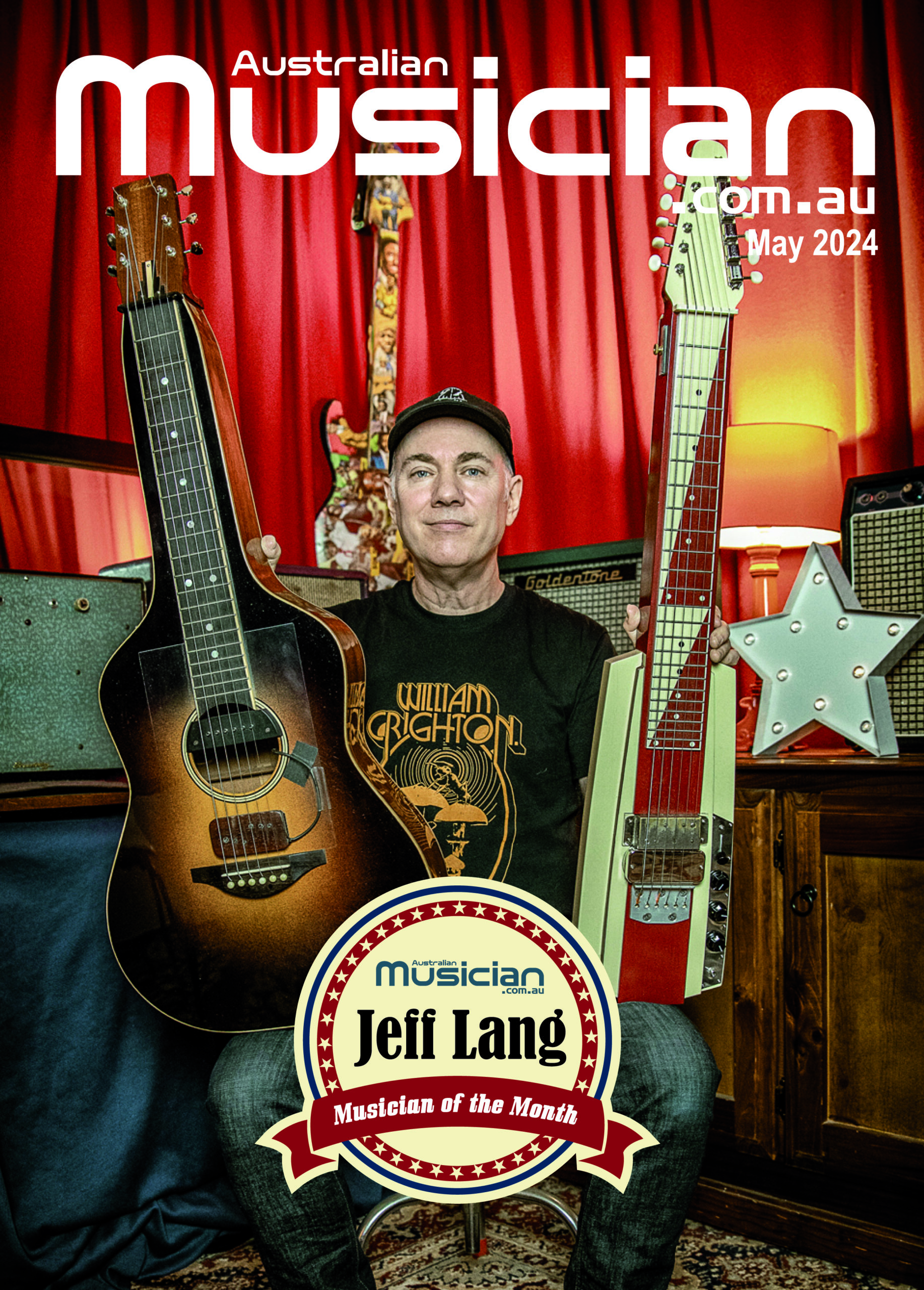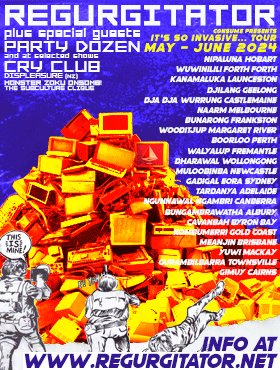RICK ROSAS – NEIL YOUNG BAND SOUNDCHECK EXCLUSIVE
June 19, 2009 | Author: Greg Phillips
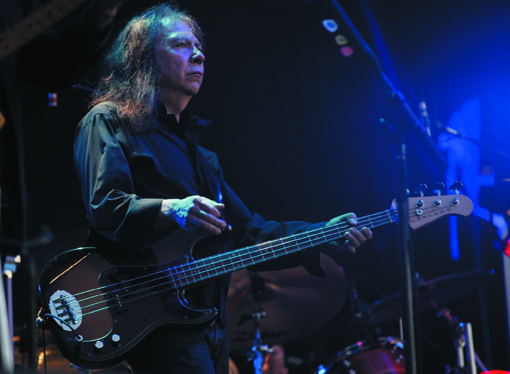 It’s the hottest week on record in Melbourne. The weather bureau suggests it is 43 degrees celsius outside. Within the close confines of the sails of the Myer Music Bowl, who knows what the temperature is? Who cares … I am privileged to be standing on stage at a Neil Young sound check. I’ve been invited down by Neil’s bass player and genuinely nice guy, Rick Rosas. On stage, the crew is having a hell of a time getting guitars to stay anywhere near in tune.
It’s the hottest week on record in Melbourne. The weather bureau suggests it is 43 degrees celsius outside. Within the close confines of the sails of the Myer Music Bowl, who knows what the temperature is? Who cares … I am privileged to be standing on stage at a Neil Young sound check. I’ve been invited down by Neil’s bass player and genuinely nice guy, Rick Rosas. On stage, the crew is having a hell of a time getting guitars to stay anywhere near in tune.
“It’s terrible,” says Larry Cragg, Young’s long time guitar tech. “They go so flat because of the heat, but you have to just keep chasin’ it. As the temperature goes down, things will start going sharp again. The guitars are red hot right now. I don’t know what it is fahrenheit but it’s disgustingly hot. I have three high speed fans blasting into the back of Neil’s little Tweed Deluxe, and that’s not good. I have two in the back of the Tweed Twin. Everything else has fans, the SVT. The Fender amp Rick is using has a fan built into it.”
For a moment it seems we’ll be allowed to stand side-stage to witness the sound check, however, manager Elliot Roberts suggests that we’ve out-stayed our welcome and ushers us away. As the opening lines of “Like A Hurricane” waft inside, there’s a collective, knowing nod of approval from those sitting nearby. Later backstage, in the comfort of the air-conditioned hospitality area, the band dine together and chat about the new tracks they’ve been road testing from the forthcoming album ‘Fork in the Road’. Young, looking exceptionally fit in straw hat, white shirt and shorts sips on a can of Canadian Dry before heading to his change room for a nap. Young’s wife Peggi mentions that it’s a regular occurrence. He won’t reappear until a few minutes prior to tonight’s show.
It’s apparent that Rick’ The Bass Player’ Rosas is a much respected and loved part of the Neil Young team. The wonderful courtesy afforded to Australian Musician on the day is due to the fact that we’re guests of Rick. Rosas first came to Young’s attention at Willie Nelson’s Farm Aid in 1986 while Rick was holding down the bottom end in the Joe Walsh band. It wasn’t until two years later however that the call came asking Rick to come down and try a few things out for the ‘This Note’s For You’ album. Rosas also played on the next album ‘Freedom’ before Young reverted to the Crazy Horse band for a while. Sixteen years later in 2005, Rosas was called upon again to play bass on ‘Prairie Wind’. Rick has held down the bass position with Young ever since.
During a busy week in Melbourne headlining the Big Day Out and playing a huge Myer Music Bowl show, Rick found some downtime to share a cool drink and chat about his career.
Reading through some of your previous interviews, we still don’t know much about your early days …
I grew up in East Los Angeles, which is not a great part of town but there was a lot of music there. Back in the day there were a lot of bands playing. There were groups like Los Lobos. We went to the same High School. I might be a year older than them. There was a big scene and a few of the acts got some fame at the time.
What about your parents, were they musical?
My dad was very musical. He played the piano and guitar, though I never really understood his stylings. I was given his blessings in any music I chose. My parents were both born in Arizona. USA. My heritage has been traced back to Spanish, and Apache … so don’t be around me at midnight, ha!
Prior to meeting Neil at Farm Aid, were you a fan?
Oh, a huge fan of Neil Young, all the way back to Buffalo Springfield. When they came out, they were one of my favourite bands in the world. I saw them play twice in the Los Angeles area, a place called Cal State, a local college. I saw them play at the Long Beach Arena, which was their farewell concert. I didn’t think they were fantastic live, but they were in the studio. At the time, PAs weren’t great. There weren’t guitar tuners … they were on their own. Stephen Stills would be on one side of the stage, Neil way over on the other, so they really couldn’t hear each other well. I still loved them anyway. One of my favourite bands to this day.
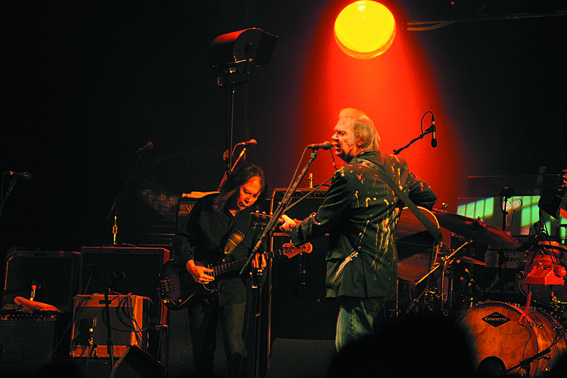 So how did that first Neil Young gig come about?
So how did that first Neil Young gig come about?
It happened because he saw me at Farm Aid in 1986. I was playing with Joe Walsh and apparently he remembered me. A year or two later he found some musicians who had worked with me. He was having problems with his rhythm section at the time. He was doing the Bluenotes band, which was the Crazy Horse guys. They were not flowing properly for that type of music. He had some friends of mine get in touch and they said Neil wants you to come up to the ranch and do some playing. I was jumping up and down saying ‘wow’. He had a lot of tracks that they had recorded live at various venues. He was trying to break in this band that had horns. He asked me to do some overdubs to see what I could do. I did a few. With some of the tracks I found that the tempos were all over the place, so it was hard to follow. I suggested that maybe we could bring in the drummer that I had been playing with, Chad Cromwell and that maybe we could do something together. So we eventually did a few months later. We overdubbed a few tracks which made it to the ‘This Note’s for You’ album. So two or three of them are live tracks he had recorded at some place with the band, and we just overdubbed drums and bass on that. Prior to that he had been auditioning a lot of people. Apparently he auditioned Larry Taylor from Canned Heat, Bruce Palmer from the Buffalo Springfield, Dewey Martin. I guess they didn’t cut that style of music he was playing which was more of a bluesier, shuffle kind of form, big band stuff. So we started recording more and more and next thing I knew I was in the band.
Your playing always blends so seamlessly with the music, it’s always at one with the music rather than standing out. Is that something you consciously try to do or does it just come naturally?
I think it’s natural. I just happen to be one of those players who tries to listen and not try to play every note I know. There are certain musicians that can get away with it like Tal Wilkenfeld or someone like Flea. They can get away with playing every note they know and they are great at it. But for me, the style of music I play, and especially with Neil’s and Joe Walsh’s music … they require just a very simple approach, not over-playing. Less is more.
The regular gig you play at Joe’s Joint on Monday nights in LA when you’re not touring … how important is that to you?
It’s very important because there are times when you are off. When you are off, you sit around you don’t do a lot of playing, so it’s great to go in and play a couple of long sets. Waddy works us very hard. He knows what he wants and he’ll be screaming at you if you don’t do it right. It turns out to be a very good work out. we’re quite exhausted by the end of it. Like I have said in the past, it’s like going to a good workout, but it’s musical.
When you’re in the studio, what’s your rule of thumb for getting a great bass sound?
We usually go direct and maybe a small Ampeg B15 I use a lot. I use a Fender style amp, which I use on stage. I used it on the new album we just recorded in New York and London. It’s coming out in about 6 weeks. It’s called ‘Fork in the Road’. Recording wise, it’s just direct and through an amp. That seems to work for me.
You could use a whole bunch of vintage basses, yet you choose to play Laklands, why?
I’m just blown away by them. I’ve played a Fender bass all my life. I still have it. It’s a ’64 Jazz bass which I have with me. I play it maybe on one song but the Laklands have a true warm sound. They are hand made. They use the finest woods and materials. I’m really proud to be part of their artist line up and they have some great players like Daryl Jones.
How many Laklands do you have?
I have about five Laklands now. They built me a new one and I use that on most of the new album. I ‘m not a huge collector but I probably have about 12, maybe 15 basses that are nice. The Bob Glaub is my main bass. It has a precision body with a Jazz neck, the Joe Osborne neck. So it’s a combination of a precision and a jazz bass.
The strings are set fairly low …
Not too low but I use flat wound strings. I used round wound for a long time, the Rotosounds, then John turned me onto the Maximus gold plated strings made in Germany. He gave me a ton of those too. So I still use those on the Fender Jazz bass. The round wounds are more of a wirey, trebly sound. Like a John Entwistle kind of sound. I have a nice piccolo bass that John Entwistle left me before he passed away. He was a big influence on me although we are different players, but I loved the way he played.
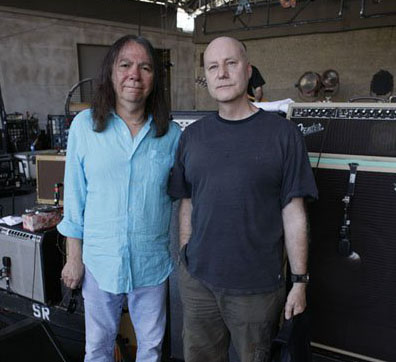
Did you use your main bass on the new Neil Young album too?
When I was in Chicago they (Lakland) were getting ready to build me a new one. They are building me one as we speak. I thought it was going to be ready and it wasn’t, so I said why don’t you give me one to take and I’ll trade it when mine is ready. Since these songs on this new album tend to be more soulful, rather than countryish .. almost like good rock and soul grooves. This time
I went with a thicker Precision neck rather than the Jazz neck.
I thought that might bring more of the Motown bass sound. They had one there in the shop that had this real nice neck and a strange body, a precision style but it has this granite counter, an interesting marble. I haven’t brought that one out with me though. I chose that for the thicker neck for these songs. So I’d never had the luxury of doing that before. I’m working closer with Lakland and they are giving me a lot more freedom to try things.
Has the heat here been effecting your gear?
It hasn’t effected the basses yet. But it did effect the bass that they loaned me, which I am going to keep after all. Prior to this leg of the tour, I went to Memphis. I’m recording an album with Jerry Lee Lewis at the moment. Ben Keith our pedal steel player is producing it. We went, for about 4 days prior to leaving for Australia … Waddy Wachtel was on the session. We went to Florida. Steve Bing is the owner of the record label and he has a private jet. They took us to Florida and we picked up Ron Wood. Then we went to Nashville and picked up Tim McGrath and we to Memphis and recorded one day there. We tracked about three songs. There was Jim Keltner, Waddy and myself and Jerry Lee, and Jerry lee’s guitar player Kenny Lovelace. What I am getting to is that I brought that bass there, thinking it’s going to be really nice, but something happened to it with the traveling. Something had changed on the neck so I couldn’t use it. Fortunately Ron Wood’s guitar guy had brought an extra bass. So I had to use this early ’60s Fender Precision bass, which was turned out to be fine. The basses on the road are looked after really well by Larry, they are always spot on. It’s quite a luxury having Larry Cragg look after them.
Let’s go through your career with Neil album by album. ‘This Note’s for You’ was first one you played on.
Most of that was recorded live or in a rehearsal room. He would rent a studio from Instrument Rentals in Hollywood. So he’d have this big rehearsal room and have a truck outside and record that way. A lot of the tracks were recorded live at various venues we played. The track ‘This Note’s For You’ was recorded at The Palace in Hollywood. They’d take the tracks and clean them up.
Does Neil give you any direction in regard to what he wants from the bass?
At times he does. He knows what he wants … he likes to hear what we do first. If he’s not hearing what he’s trying to put across, he will try to give us an idea of what he’s going for. But he does give us a lot of freedom, which is nice.
Which brings us to the next album which is ‘Freedom’, and the first time you got to play on what has become a Neil Young classic,
‘Rockin’ In the Free World’.
I was very proud to be a part of that. That recorded at his ranch he had a barn and again, he had the truck outside. It’s not like a recording environment. It’s just like you are rehearsing. It feels comfortable.
There was a bit of a gap between albums for you before 2005’s ‘Prairie Wind’.
Sixteen years I think. Neil always has, and to this day will probably continue to work with other people. You can’t blame him. It’s how he grows. I’ve been fortunate to have been working with him this run since then. I just finished my fifth album with him. He’ll probably go back to Crazy Horse. You can’t beat their sound for what they do. I loved playing with Ralph Molina. He was on the road with us for a while, a fantastic drummer and singer. I played with Poncho back in the late eighties and he’s a great guitar player and singer. Of course I haven’t player, with Billy Talbot the Crazy Horse bass player, but another great player. What they do is very simple and very unique and I have total respect for them. But he’s used a lot of great studio musicians, Donald ‘Duck’ Dunn, you know. I was lucky to get a call from Neil after he’d been playing with Duck.
‘Prairie Wind’ has a different sound to what he’d been playing, more of a country feel.
Definitely. He wanted to record in Nashville. We had talked a lot. He would stay in touch even though we hadn’t seen each other for a long time. I think he liked the idea that I wasn’t just sitting around, I was doing the Monday night gig. So I told him my playing was up to par and give me a call when you are ready. Finally his management called and wanted me in Nashville the next day. You have to drop everything but I was thrilled. It was great to work with some musicians I had never worked with before like Spooner Oldham. I was a big fan of his playing and great to be playing with Ben Keith again. The drummer who was first doing the sessions was Karl Himmel. Karl was very a known studio drummer in Nashville in the 70s. He played on parts of ‘Prairie Wind’. He seemed to be limited at the time. I spoke to Neil and thought that he wasn’t really putting across the parts the way I think it should be done, it would be great if we could get Chad in again. It wasn’t entirely all my idea, but I was kind of rooting to get Chad back. I mean I did like Karl, he’s a great player too, but Chad had just been on a tour with Mark Knopfler and apparently he was not happy on the road with him. There was a lot of stress, day to day grind. They’d do five or six shows a week and it got mentally and physically tiring … he just wasn’t happy. So when Neil called him, he was down here in Australia I believe. So when he came home, he had maybe a day at home and he joined us. He finished the rest of the ‘Prairie Wind’ album. So that brought us all together.
Next up ‘Living With War’ which was different again, just Neil you and Chad Cromwell … Neil was writing songs on the spot.
I think he had a couple of songs written and he said come on up to the ranch. We would track a song, take a break. He’d go away for a while and come back and say ‘Got another song!’ Next day he’d have another song or two. We recorded that album in a period of no more than five or six days. That one went to tape immediately. It was controversial because of the songs about the President and all. I loved it because I never cared for George Bush. Neil said to us ‘You guys don’t have to play on this record if you don’t want to get yourselves into trouble’. I mean Chad comes from a very Republican state, Tennessee, what they call a red state. So he was like, ‘Hey when I get home, I’m gonna have to hide for a while!’
Then you went out and played it live with Crosby, Stills, Nash and Young.
While making that album he took me aside and he asked if I’d consider playing with those guys. I just said, are you kidding me? I love that band too. Stephen Stills was a great influence on my bass playing. He’s a great bass player. That first CSN album, he plays all the bass on it and I got to use his bass. He brought it out for me on the road and I used it for a certain segment of the set. We did ‘Helplessly Hoping’ and ‘Southern Cross’. So I got to play his 58 Precision bass. David Crosby bought it for him and he calls it grandma. So it was like, ‘I’ll bring out Grandma’ for ya’. It was a real treat and I hope to work with them again.
‘Chrome Dreams II’ was next. It features a couple of very long tracks.
Yes, one of them was ‘Ordinary People’ which was recorded in 1989 or 88 and I don’t even know how that came to be on there. Prior to recording the album, Neil called me and said ‘What are you doing?’ And he asked me what I was up to. He said “You know, I feel like playing … you feel like playing? Why don’t you come on up?’ He asked if I had ever played with Ralph before and I said no but I’d love to. With Neil you never know what he is going to do. When I approached the ranch, I was thinking we were just going to jam and try some stuff out. Next thing I see a big truck outside, so I thought, man we’re going to record. We were up there a couple of weeks. We recorded in a new room he built, which was like a garage where he stored some of his cars. There’s a picture of it on the Chrome Dreams album. It looks like a gas station. It’s really cool in the middle of the Redwoods forest and it’s just a big room with this truck outside recording.
Is it more difficult recording one of those longer tracks?
The song ‘No Hidden Path’ which I think is about 12 or 14 minutes long … we played that a lot. At least 24 hours in a period of two or three days. He has this unlimited energy, I don’t know where it comes from. It’s not from drugs .. anymore. I don’t know where he comes up with it, but you just better be ready is all I can say. We are not about to let him down.
In between tweaking instruments at sound check, Larry Cragg, Neil Young’s long time guitar tech (and the guy responsible for much of Neil’s album sleeve photography) sat down to describe Rick Rosas’ signal chain.
“The first thing it hits is an Ampeg SVT-di. Out of that it goes into a Jonathon Little Little Labs splitter device which is an active splitter. It goes from there into the real Ampeg SVT, which is a 1970 SVT head, which is actually mine. Then there is this other amp that I built which is very special. The speaker cabinet is a single Fender Showman cabinet which has the tone ring. It has two baffles and the sound comes around the rear baffle around the edges and ends up coming out around the speaker which is mounted on this tone ring. It gives a really special sound, you can really hear it. Then the head is a one off. It started out as a Hi Watt version of the Vibrosonic Reverb, which is like an 8 ohm twin reverb .. a twin reverb with an 8 ohm transformer, but it is not the 100 watt. It is the 130 watt. So instead of about 400 volts zappin’ around in there, it has about 700 volts. It gives it a lot more poop and I have Blackfaced it and Sal Trentino blackfaced the the power supply. It was a very funky power supply that came with those in that era. They just made them at the very end. They are really powerful and have huge transformers in them.
I feel that the Fender front ends have the ultimate EQ for a bass, I really like it. Put it on 6 treble, 5 middle and 6 bass, and you can’t go wrong. Then there’s headroom too because this is the Hi Watt one. So the combination of those is just fantastic. So there’s both that and the early 70s SVT and of course you have to make sure the polarity is correct between the two. You always have to check that.”

